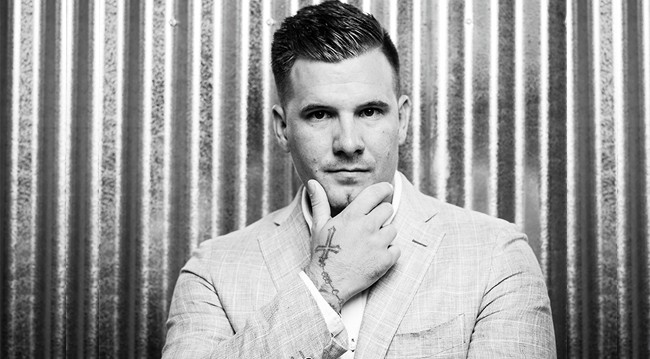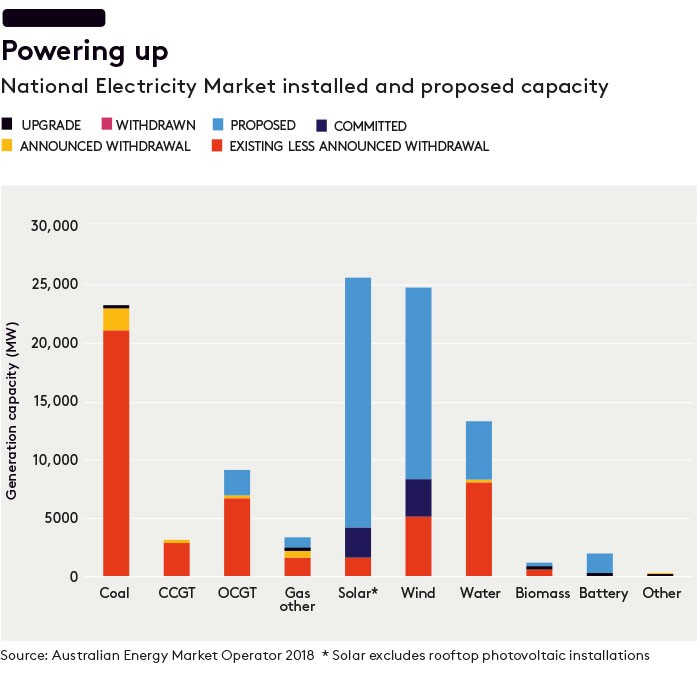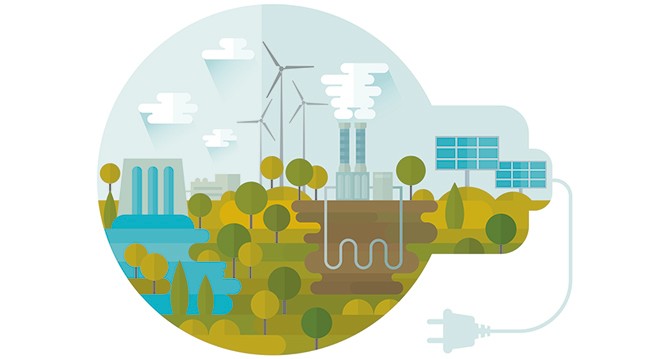Energy policy and rising power costs have become major concerns for Australians. Here's how boards are responding to Australia's energy crisis.
Joel Heazlewood MAICD, managing director of Queensland based Coxons Group Australia, got tired of getting slammed by rocketing energy bills (QLD consumer electricity bills increased 136 per cent in 2006–16 according to the Clean Energy Council). Headquartered in Rockhampton and operating in Townsville, Queensland and Newcastle, NSW, it had seen its power costs go up 35 per cent. Heazlewood spent $34,000 installing a 30kW solar power unit in 2018. Coxons Group supplies mining, transport and industrial cooling components and heat transfer equipment such as nosecone modules for mining trucks.
“We wanted to lower our power bill, have more control and have a plan to go off the grid if required,” says Heazlewood. “We don’t want to be locked in if prices go up. The solar install has reduced our power bill by 40 per cent — saving over $10,000 a year. Most importantly, it increases our electricity capacity by 30 per cent during peak demand, daytime. We can track all the power we consume, what our solar produces and what we put back into the grid, which gives an idea of what we’ve saved on power.”

Heazlewood is concerned about rising energy costs and the transition to a low-carbon future. He’s also frustrated at a decade of dead ends and lost opportunity with Australia’s energy policy. “We’re not having the real conversation, in my opinion. There’s been no proper energy policy for a decade.”
His company is a classic example. His business relies on the resources sector for its livelihood, has invested in solar and meets ISO standards for water, energy and environmental footprint. However, he also believes coal and nuclear fuel need to be part of the discussion about future-proofing energy use.
In AICD’s recent Director Sentiment Index, 50 per cent of directors rated energy policy as the top issue government should address in the short term (up from 42 per cent in 2017). In the longer term, 30 per cent rated climate change (up from 24 per cent). And 84 per cent of directors rated the current quality of public policy debate in Australia as poor.
Martin Moore GAICD, founder of Your CEO Mentor and former CEO of Queensland company CS Energy, says vested interests make it hard for directors to work out fact from fiction. “Australia has faced a decade of climate and energy policy turmoil that now sees businesses and consumers paying some of the highest prices in the world while battling to keep the lights on.”
He says the federal government’s plans for cutting electricity prices are market interventions unlikely to produce the desired result in any reasonable time frame, while putting taxpayers’ money at risk. “The threatened re-regulation of retail prices would do little more than stifle competition and innovation, while tapping another nail into the coffin of sovereign risk.”
Alison Crook AO FAICD, chair of community-owned renewable energy provider Enova Energy, says the energy debate is so charged in mainstream media that “the challenge for boardrooms and organisations is the quality of information available to make the right decisions about energy policy, use and costs”. This complicates an already substantial challenge for organisations managing rising expenses for what is, for most, a substantial cost of doing business and ensuring they reduce their carbon footprint in response to growing climate risk.
Energy strategy
Rob Sindel GAICD, CEO of building products company CSR, says energy price shocks make it hard to manage energy strategy, already a challenge for the board, which requires long planning. “When you get the opportunity to build a new plant, you can lower the energy intensity by using the latest technology and more efficient electric motors, but you can’t do that at every plant,” he says. “You can’t just rebuild them with the latest technology, you’ve got to operate within the confines you have until it’s time to rebuild. If energy costs are going up a couple of per cent a year, you can transition your businesses. When you get these shocks in the system, it’s very challenging to manage.”
Soaring energy costs have hit hard on the bottom line at the company, one of Australia’s oldest manufacturers. Energy costs for CSR’s building products and glass businesses jumped 14 per cent on the previous year, to more than $100m for the year ended 31 March 2018. “That’s a $26m increase in two years, and that doesn’t include Tomago,” says Sindel, referring to CSR’s 25 per cent stake in Tomago Aluminium, a joint venture between CSR, Rio Tinto Alcan and Hydro Aluminium. The NSW aluminium smelter operates 24 hours a day.
Tomago’s costs are up $150m in a year following a new long-term electricity contract that started last November, Sindel says and the new electricity contract results in a decline year on year of $50m in CSR’s profitability. “With Tomago, thankfully, the aluminium price is higher and the currency lower, and it’s sold in US dollars so it’s still viable, but what it means is that globally it’s much less competitive than it was previously.
Sindel says the cost had significant impact on CSR’s building products business. “We can put up the price of bricks or plasterboard and hopefully cover it, but where we are trade-exposed, competing with products from overseas, you either wear the margin, lose the business or close down,” he says.
CSR’s new $75m Hebel autoclaved aerated concrete plant, scheduled for completion in March 2019, showcases much more efficient new technology in automation and environmental and waste management.
Sindel is critical of the national debate on energy policy. “Too much of the energy debate focuses on solar applications. But transitioning industry is not like that, you can’t just put solar on the roof. The world’s biggest battery in South Australia would power Tomago for just eight minutes [Tomago represents 12 per cent of NSW energy consumption]. What happens at peak times, you need transitional generation, which was meant to come from gas and a lot of those gas resources have been locked up by state governments. We are exporting a lot of that gas, and gas prices have gone up substantially in Australia. There’s a myriad of issues undermining the competitiveness of Australian manufacturing.”
He says the CSR board is aware there is no silver bullet, only a series of things a company can do to manage it. “We can look at the forward curve for electricity and we know what our gas prices are going to be so we plan two things — either pull out of certain products or markets, or push our prices up, which means costs for housing go up. Ultimately, the consumer pays because prices go up or jobs are lost and the product comes from overseas.”
CSR also set environmental targets in 2010 to reduce greenhouse gas (GHG) emissions, energy and water use and waste production by 20 per cent per tonne of saleable product by 2020. It has already achieved the GHG emissions and waste target. Further work is underway on water and energy consumption. Reduction projects are underway at all sites and post-2020 targets are under review.
“Part of the strategy was saying, ‘let’s put in some capital with a $20m energy improvement fund to accelerate some of those energy improvement initiatives’,” says Sindel. “Other strategies include consolidating plants or improving energy efficiency, but in many cases we’d do this anyway because the cost of energy is such a large proportion of our overall cost. But what you’re doing is chasing your tail and passing on bigger price increases to cover the higher energy costs.”
Sindel says that boards can adopt a number of strategies to help future-proof energy. “The first thing is that companies have to be more efficient and much better at using the finite energy reserves that we have,” he says. “They have to ensure that waste is minimised and develop a planning process around this for what’s going to happen in the next few years and how they’re going to manage it.”
Another is to look for opportunities to cut unnecessary expense. CSR found the opportunity to go to the wholesale gas market rather than buying from a retailer. “We went up the supply chain. We became an operator in the wholesale market and cut out one step in the process.”
And it’s important to audit and monitor energy use. “Our teams are watching the price of energy by the five-minute interval and adjusting the plant with reference to changes in energy costs during the day.”
Energy audit
In south-west Sydney, Bankstown Sports Club CEO Mark Condi says energy was the highest cost for the organisation outside of wages. One of Australia’s largest registered clubs with 75,000 members, the club operates 24 hours a day. Its energy costs were rising eight to 10 per cent a year.
“Energy was our largest cost and it was growing at a significant rate without any significant forecast of it stabilising,” Condi says. “There was no discussion at a national level of those costs stabilising in any way.”
The club turned to the Clean Energy Finance Corporation (CEFC) to install its energy-saving systems, replacing two of its three water-cooled chillers with a new energy-efficient chiller and cooling tower. This saved more than five per cent on energy costs, reduced energy usage by about 21 per cent a year and reduced carbon emissions by more than 100 tonnes a year. It also installed solar photovoltaic panels at its associated venue, Baulkham Hills Sports Club, which Condi estimates will save $100,000 a year.
He says organisations should be doing energy audits. “It’s not only about energy, there’s also water consumption and water harvesting. Every company has an obligation to be investing in these things, not only to employees and other stakeholders, but also the country.”
Plus, he says, there’s been a payoff for staff and customers. “We find that our staff are passionate about what we’re doing in terms of solar, rubbish recycling, what happens to the food waste and the way we use water.”
Keeping cool
RACV Noosa Resort brought in Zen Ecosystems to design an intelligent energy management system to address energy costs rising 10 to 15 per cent a year. Resort manager Darren McClenaghan says the problem was that air-conditioning units in the resort’s 170 apartments were left running when guests checked out. Sometimes, staff would not get around to switching them off for days. With the web-based Zen system, the air conditioning could be turned off via computer or mobile phone.
“The business driver was the cost saving, but we are also now operating in a more sustainable way,” McClenaghan says, adding that the first step for businesses should be an audit of their energy use.
“The RACV as an organisation has done a lot of energy audits right across the group. There are organisations that can come in and work out what’s the capital, what the payback is,” he says. “My advice for all businesses would be to get someone in to do an audit. Not just electricity, but also waste water, gas. Green saves money.”

The great debate
AICD members who spoke to Company Director had vastly different views on Australia’s energy fix, but they all agree we need to cut through ideology and consider the facts. National leadership is required and Australia needs to have a proper conversation.
Heazlewood says that conversation needs to be around how Australia meets the energy needs of a growing nation and the increasing extreme weather patterns and need to reduce emissions.
“Until both parties agree on the direction of this country, and that energy is important, we’ll have problems.”
Martin Moore says policy intervention to drive the right market responses should be the objective. “This would best be achieved by putting a price on carbon and letting the market work it out from there. Unfortunately, that’s political suicide.”
He says more workable are the recommendations of the Finkel Review and Energy Security Board to balance the transition to a cleaner energy system, without further damaging system reliability or diverting billions of dollars into compensation schemes. “We need a courageous government willing to take a long-term view of the energy industry and not just play for the short-term electoral sugar hit of handouts and dubious promises of future price reductions.”
Cleaning up our act
Australia’s Clean Energy Finance Corporation (CEFC) is an example of how targeted use of public policy can provide huge payoffs. A statutory body established by the federal government under the Clean Energy Finance Corporation Act 2012 (Cth), its role is to help organisations and businesses fund sustainability and energy savings. Governed by an independent board, it has access to $10b in capital to invest in clean energy.
Amid a fractious public debate and in 2013 threatened with shutdown, the corporation is regarded as a leading international model. In five years of investing, it has contributed to clean energy projects across Australia with a value of $19b — a record $2.3b of that in 2017–18.
It has also directly invested in more than 110 individual transactions and financed more than 5500 smaller-scale clean energy projects through partners. New commitments in 2017–18 included $1.1b in renewable energy, $944m in energy efficiency, $100m in transport and $127m in waste-related projects.
CEFC chair Steven Skala AO says in its 2017–18 annual report that his organisation has a clear charter to be a catalyst for investment in and financing of clean energy to achieve the long-term goal of decarbonising the Australian economy.
“Our methodology is to seek to crowd in private sector investment and engage capital markets to operate effectively in the private energy sector.”
He says 2018 saw industry seizing the challenges and opportunities offered by decarbonisation and accelerating its consideration of emerging duties associated with carbon disclosure. “The financial markets have also moved in this regard. The question now is not one of direction, but of pace.”
The corporation’s annual report says lifetime cuts to greenhouse gas emissions of more than 190 million tonnes of CO2 equivalent are forecast from its portfolio (once funds are deployed and projects fully operational). Projects include:
- $94m invested in Kennedy Energy Central Park in central north Queensland, providing energy for communities from Julia Creek to Charters Towers
- $90m for Mirvac to provide first and new home buyers with built-in solar and battery systems
- $30m to help Resource Co produce processed engineered fuel (PEF) from commercial and industrial waste
- US$100m senior secured bond issued by Pilgangoora Operations, a wholly-owned subsidiary of ASX-listed Pilbara Minerals, to finance the development of the Pilgangoora lithium-tantalum project in WA, important for electric vehicles and battery storage.
Finkle Review at a Glance

Energy fix
In 2017, the Finkel Review proposed three pillars to transition Australia to low-emission energy based on:
- Orderly transition: Clean Energy Target (CET) calibrated on Paris Agreement reduction targets. Large emission power generators required to give three years notice of closure.
- System planning
- Across national energy market grid to aid investment and efficiency.
- Regional security and reliability checks.
- Priority project list.
- Stronger governance: Energy Security Board (chair Dr Kerry Schott AO) to coordinate three market bodies:
- Australian Energy Regulator
- Australian Energy Market Commission
- Australian Energy Market Operator
- Annual health check performance.
Next steps
By 2020, develop whole-of-economy emissions reduction strategy for 2050.
Progress so far
National Energy Guarantee proposed to legislate a target to cut emissions 26 per cent for the next 10 years, with a review in 2025 and any changes to apply from 2030.
Latest news
Already a member?
Login to view this content


